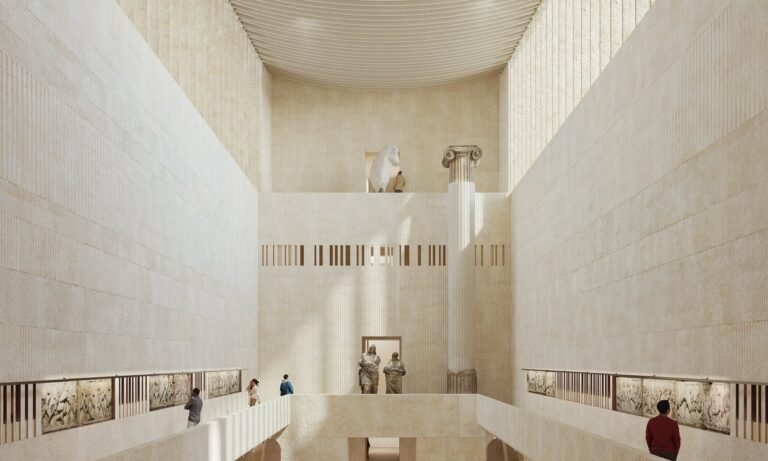Architect Lina Ghotmeh has won the competition to redesign the Western Range galleries at the British Museum in London, beating Rem Koolhaas and David Chipperfield who were also shortlisted for the ambitious overhaul.
A total of five architect-led teams were included in the shortlist, which was announced last year, with each hoping to lead a revamp the British Museum has described as “one of the biggest cultural renovations undertaken anywhere in the world”.
Ghotmeh designed the 2023 Serpentine Pavilion in London and has also been commissioned to design a contemporary art museum in the AlUla heritage region in northwestern Saudi Arabia. An online biography, which describes her as a “humanist architect”, says that in 2005 she won the international competition for the design of the Estonian National Museum while working in London, collaborating with Ateliers Jean Nouvel and Foster & Partners.
The architect’s British Museum team includes the artist Ali Cherri, whose works explore geopolitical and cultural histories. “Lina will be consulting with Ali as part of the wider consortium of people who will lend their expertise to this project,” says a museum spokesperson. Her practice, Lina Ghotmeh Architecture (LGA), will work with the museum to develop initial designs by mid-2026.
In an Instagram post, the British Museum director Nicholas Cullinan wrote that Ghotmeh’s initial ideas “unanimously impressed the jury with their beauty, sensitivity and ingenuity and for her deep interest in archaeology”. These ideas include re-using rubble from the building process “to line the walls of the Lycian wing to ravishing effect”. Ghotmeh’s project slides, shown on Cullinan’s Instagram feed, depict a gallery housing the controversial Parthenon Marbles.
Last year Ghotmeh told the Robb Report publication: “The field of archaeology is always telling you stories about how we used to build and interact with our environment, constantly putting in perspective what has been done already… It’s not just an obsession with ecology, it’s also a quest for more sustainable materials. Any act of building has to have a positive impact on its environment.”
The competition judging panel included ten art and architecture experts including the Irish academic Yvonne Farrell and Meneesha Kellay, senior curator, contemporary at the Victoria and Albert Museum. The chair of trustees, George Osborne, along with other trustees including the artist Tracey Emin and the UK businessman Charlie Mayfield, also informed the decision.
Controversial masterplan
A vast swathe of the museum’s display space—encompassing the “Western Range” which currently houses collections such as Ancient Egypt, Greece and Rome—is set to be redesigned under the revamp. The Western Range covers a third of the museum’s overall gallery space, as well as back-of-house areas, totalling 15,650 square metres.
The complex of spaces range in age from the original 1850s buildings designed by Robert Smirke, as well as later additions such as Gallery 10 and 22. “All of the buildings are in need of upgrade to meet contemporary building performance standards, and many contain highly significant heritage building fabric,” the museum previously said in a statement.
The Western Range refurbishment is part of the wider museum masterplan which also includes a new museum Energy Centre designed to phase out the use of fossil fuels, replacing them with low-carbon technologies. This project—partly funded with government support—should save 1,700 tonnes a year of carbon dioxide, making the institution more sustainable. The museum also opened a new £64m storage and research facility in Berkshire last year called BM_ARC.
The cost of the full masterplan project is likely to reach hundreds of millions of pounds, possibly more than a billion. In a controversial move, the oil and gas company BP is to give £50m over the next decade to help fund the redevelopment. In response, environmental campaigners called on prospective architects not to take part in the contest.

